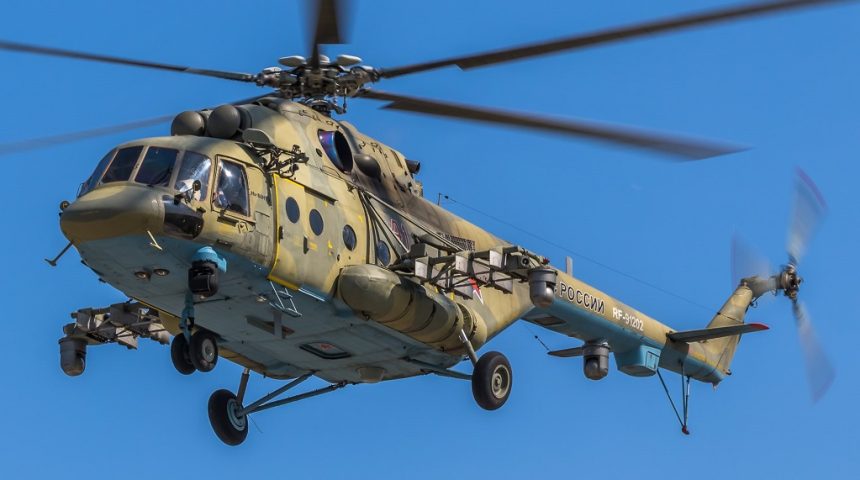We have talked about the U.S. DIRCM systems, now we report about their Russian counterpart that is part of the latest upgrades for the helicopter fleet.
Since the beginning of the 2000s, we have observed an increasing usage of Missile Warning Systems (MWS) aboard air assets. The lessons learned from recent conflicts, like Afghanistan and Iraq, underlined the need to protect low flying aircraft, and especially helicopters, also from MAN-Portable Air-Defense Systems (MANPADS) threats, other than direct fire that is contrasted with the use of armor. During the last 10-15 years, almost all western aircraft deployed for combat operations had at least ultraviolet-based MWS (Missile Warning Systems) to detect incoming missiles. That was not the case for eastern armed forces, and especially Russian forces which are deployed in Syria since 2015 with their air assets.
The general lack of infrared countermeasures against MANPADS aboard Russian aircraft was remarkably demonstrated when in 2017 President Vladimir Putin visited Hmeimim Air Base, the Russian permanent base near the Syrian port city of Latakia. In that occasion, Putin’s Tupolev Tu-214PU (RA-64517) was escorted by two Su-30SM fighter jets that acted as “heat traps” to attract possible MANPADS and deploy flares to foil them, making up this way to the lack of protections of the presidential aircraft. This need was dictated by the reported presence of at least three different types of MANPADS in Syria: the Soviet-era 9K32 Strela-2 (SA-7 “Grail”) and 9K310 Igla-1 (SA-16 “Gimlet”), and the Chinese FN-6 Hongying-6.
American aircraft are using a combination of UV MWS, flares and Directional InfraRed Counter Measures (DIRCM) to defend themselves. Russian armed forces are seemingly following the same approach. The system that is being increasingly installed on all Russian helicopters, and also on some fixed wing aircraft, is the Vitebsk BKO L370, more commonly known with its export designation President-S, first appeared in 2015/2016. The system was reportedly in development at least since the first 2010s but was never installed on operational aircraft.

According to the Russians, the Vitebsk L370 in its complete configuration is designed to protect an aircraft from both IR and radar-guided missiles, which “can be tracked within a radius of several hundred kilometers”. The Vitebsk is actually a modular system with components installed both inside the aircraft or on external attachment points.
The main components of the Vitebsk system are (disclaimer: all data presented here are public and not classified):
- L370-1 control unit, processes the information received from the radar, laser and infrared warning sensors to activate automatically the jamming system and countermeasures, while alerting the pilot and providing information about the threat;
- L150 “Pastel” Digital Radar Warning Receiver, with sensors mounted in the tail, wingtips and nose, works in the 1.2- to 18-GHz range frequencies and covers 360° horizontally and 60° vertically around the aircraft;
- L370-2 UV warning sensors and L140 Otklik laser warning sensors, detect IR signature from incoming missiles and laser designators, respectively;
- L370-3S digital active jamming station (currently not installed on operational aircraft), can locate the hostile emission’s azimuth with a 5°-10° accuracy and jam the signal in two sectors (front and rear) 120° wide horizontally and 60° vertically;
- L370-5 IR jammer (replaced by L370-5L or L418-5 in some configurations), a laser-based Directional IR Countermeasure (DIRCM), externally similar to a normal EO/IR sensor turret, which can “blind” the missile at a range from 500 to 5000 meters, covering 360° degrees around the aircraft and 90° vertically;
- UV-26 countermeasures dispensers, each module can house 32 rounds of 26mm flares/chaffs;
- Active Towable Radio-location Trap (ATRT), planned only for heavy fixed-wing aircraft, is an expendable towed radar decoy attached to a 150 meters long cable that lures radar-guided missiles away from the aircraft.
The known specific configurations are L370E31 (Ka-31), L370V50 (Ka-50), L370V52 (Ka-52), L370E8 (Mi-8MT), L370E26L (Mi-26), L370V24 (Mi-24), L370V28 (Mi-28), L370K25 (Su-25).
The Ka-31 AEW helicopter features L150 sensors in the tail and four L370-2 sensors coupled with two L370-5 jammers under the front and rear fuselage. The Ka-50’s and Ka-52’s versions feature L150 sensors in the tail, L140 and L370-2 sensors in both the nose and tail, two L370-5 jammers just in front of the main landing gear and UV-26 dispensers in the wingtips. The L370-5 jammers are being replaced on new aircraft by the L418-5 jammer, the main visible difference is a round vs square sensor in the turret.

The Mi-28’s version is identical, except for the two L370-5 jammers replaced by a single L370-5L jammer housed in a transparent dome. The Mi-8’s and Mi-24’s versions seem to lack the L140 and L150, featuring only four L370-2 sensors, on the Mi-8’s wingtips and on some custom bulges behind the cockpit and on the tail on the Mi-24, and three L370-5 jammers, one under the tail and the others on the Mi-8’s wingtips and behind the Mi-24’s main landing gear. Both helicopters have also UV-26 dispenser on the rear fuselage. The Mi-26 uses two external pods to house the L370-2 sensors and the L370-5L jammer, one for each side, while the UV-26 dispensers are mounted on the lower fuselage.
The only tactical fixed wing aircraft to use Vitebsk is the upgraded Su-25SM3, latest version of the Su-25 “Grach” (NATO designation “Frogfoot”) which features the L-150, three L370-2 sensors, two in the tail and one below the nose, UV-26 dispensers and two L370-3S jammers mounted under the outer wing pilons, previously used for the R-60 IR-guided air-to-air missile. According to the Russians, the Vitebsk computer can also provide to the Su-25SM3 targeting data for the Kh-58USh (AS-11 ‘Kilter’) anti-radiation missiles.
While the system is being upgraded based on the experience from combat operations in Syria, new configurations are being developed for the Il-76 “Candid” and derivatives, the Il-96s and Tu-204s used by the presidential fleet (Rossiya Special Flight Detachment) and even civilian airliners. The new Mi-38T is also reportedly receiving the Vitebsk system, with a configuration called L370V38S that should be similar to the one used by the Mi-8 and Mi-24.

Vitebsk currently equips almost all the helicopters in the Russian Air Force, according to the MoD, while the export variant, President-S, has been delivered to Egypt for their Ka-52s and Mi-17s, Algeria for their Mi-17s, Mi-26s and Mi-28s, Belarus for their Mi-8s.
The Russians refer to the system as invincible, after full-scale live fire test were performed with a real Mi-8 on an elevated platform, with its engines running and no crew, at which “20 Igla-type missiles were fired and not one of them hit the target”, as they were reportedly blinded by the jammers and flares. We don’t know how accurate are those reports as some of the Russian helicopters equipped with Vitebsk were lost in Syria, even if officially those crashed were not due to hostile fire.
The new Su-57 “Felon” supposedly features a DIRCM system too, even if not related to Vitebsk, called 101KS-O and part of the 101KS Atoll Electro-Optical System, which is a novelty for a tactical jet. Similarly to the Mi-28’s L370-5L jammer, the system is housed in a transparent dome and mounted on the dorsal spine and under the fuselage of the aircraft.









